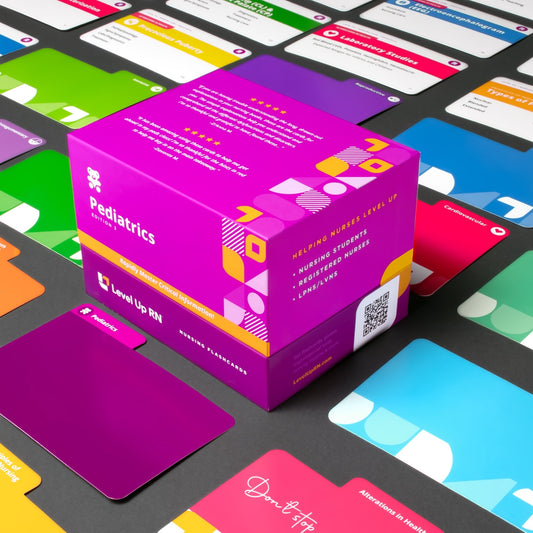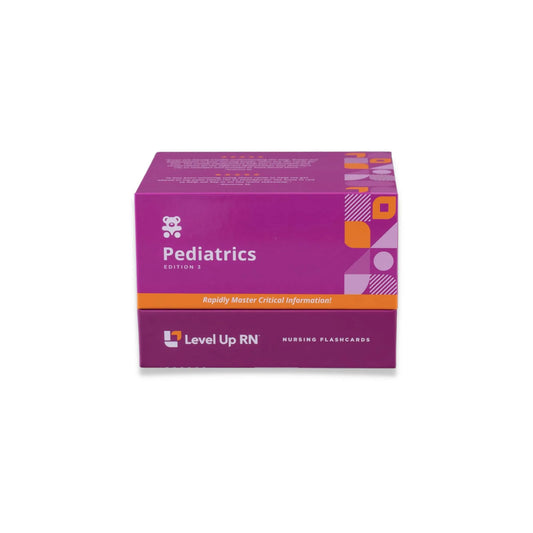Peds, part 12: G&D - School-Age Children - Development and Parental Guidance
The normal growth and development of school-aged children (ages 6 to 12 years old). Physical development, cognitive and psychosocial development, and parental guidance for topics such as sleep, sports/bicycle safety, and vaccinations.
Full Transcript: Peds, part 12: G&D - School-Age Children - Development and Parental Guidance
Full Transcript: Peds, part 12: G&D - School-Age Children - Development and Parental Guidance
Hi, I'm Meris with Level Up RN. And in this video, I'm going to be talking to you about the normal growth and development of school-aged children, which is children ages 6 to 12 years old. I'm going to be following along using our pediatrics flashcards. These are available on our website, leveluprn.com, if you want to grab a set for yourself. And if you already have your own deck, I'd invite you to follow along with me. All right, let's get started.
So first up, we're talking about physical growth and development. We've really leveled out on a lot of our physical growth here. They're going to gain about two to three kilograms, which is 4.4 to 6.6 pounds per year. And they're going to grow five centimeters or about two inches per year. So that's going to be pretty common in all of them. They should lose all of their deciduous teeth, meaning their baby teeth or those that fall out during this stage. Usually, it's going to start-- around six years old is when that first permanent or adult tooth is going to erupt. Now, gross motor skills that they should be able to do - big movements, big muscles - bicycling, jump-roping, and skating. Fine motor skills - little movements, little muscles - crafts, card games, and board games. You can see we're getting kind of less specific here as we get older. Now, when we talk about cognitive and psychosocial development, they are in the concrete operational stage for cognitive development. And that means that they use concrete terms to explain what, how, why, etc. So they're really starting to understand kind of how things work in the world. And this is so important. This is when they learn to view things through another person's perspective. So if someone did that to me, I would feel sad. So she probably feels sad-- or starting to consider the feelings of others. This is a big thing because we're going from being all about me to considering how other people fit into the world around us as well.
Now, psychosocial. We are in that industry versus inferiority, which means we love things like crafts, schoolwork. If you think about who says that they love school, it's these little kids, right? 6 to 12 years old love school. They're in that Erikson stage of industry versus inferiority. Learning and doing and making makes me feel like I am contributing to myself, my growth, and the world around me. So at this time, they are engaging in fully cooperative play, which means that they are playing together in an organized manner. And a good example of this would be organized sports. That's going to be something that we would see in this age range. Also, peer interactions are so important at this age. So for instance, if we had a child who was hospitalized and was school age, in a non-COVID time, we would want to encourage visits from their school friends, from friends in their age group. We would want to encourage them to do their homework to keep up with the class while they're in school. They're really going to meet that Erikson stage very strongly with that.
Lastly, we're going to talk about parental guidance for sleep, sport, safety, and vaccinations. So sleep, well, they're going to sleep about 11 and a half hours a night at five years old. And then when they get to 11 years old, that's kind of where we see it drop off. And now, they're sleeping about 9 hours a night. They're getting more towards that adult sleep cycle and not sleeping for like 12 hours like the preschoolers do. Now, sports and bicycle safety, this becomes an issue because we become more active. And that's awesome, but we are also more accident-prone, right? We can have more injuries. So when it comes to sports, any sort of contact sport, they should be wearing a properly fitted helmet with eye protection, a mouth guard, and protective pads, whatever that might be appropriate for the sport.
Bicycles. This is so important. And I don't know about you, but I had bicycle safety training when I was actually in elementary school. And it kind of sticks out in my mind as a thing because I thought it was so cool because I know how to ride a bike now. So they're going to teach me how to be safe. So we should ride with traffic single file, meaning if I'm riding with my bike-- or riding with my friends, we are riding in a line, right? We're not all bunched together on the road. We're going to use hand signals. That's, oh god, left turn and right turn. [laughter] Clearly, I don't remember that from bicycle safety, but they should use hand signals to communicate what they are doing. And you would want to refresh yourself on what those hand signals are. It's been a long time since I rode a bike if we're being honest. Proper lights. So when I rode a bike in very rural Virginia, I actually had a little headlight and a little tail light so that no matter which direction you were coming from, you could see me. And reflectors. So that should be on the bike itself and perhaps even on the child, such as their helmet. They should be wearing a properly fitted helmet and things like elbow pads, knee pads, etc.
Now, vaccinations. They should still be getting their seasonal flu vaccine. Don't forget about seasonal flu when you're thinking about vaccination schedule. If they are over six months and it is seasonally appropriate, they should be getting that vaccine. Now, between 11 and 12 years, you're going to see something very different. In all the previous videos, we talked about how the kid is getting DTaP, DTaP, DTaP. Well, now, between 11 and 12 years, they're getting Tdap. So we're getting tetanus, diphtheria, and acellular pertussis. Tdap, it's the same protection, right? It's protecting against the same things, but it is a different formulation. And it is what you as an adult get. So it's very important to recognize that slight difference. Tdap. Again, remember, it's alphabetical. So DTaP is for the little kids. Tdap is for the older kids and adults. All right. They're also going to get meningitis vaccine. And you'll see that abbreviated as MenACWY. I don't know why, but that's how we abbreviate meningitis. And then HPV, the human papillomavirus, they should be getting that vaccine as well. That is two doses that they should be getting of HPV vaccine. Now, we have a nice cool chicken hint here, which says "ta-da, human Men". I like to think of this as you are now in school. You're like a whole person now. So "ta-da, human men". So 'ta-da' for Tdap. And then 'human' for HPV and men for meningitis.
All right. I'm going to ask you some questions to test your knowledge of key facts I provided in this video. Let's see how you do. All right. First up, tell me around what age do we expect to see a child's permanent teeth begin to erupt? Next, I want you to tell me into which Erickson's stage does a seven-year-old likely fall. And lastly, I want you to tell me what vaccines should an 11- or 12-year-old receive? All of them. All right, let me know how you did in the comments. I'm sure you killed it. But if you need a refresher, we've got a lot of peds videos in this playlist. Thanks so much and happy studying.


